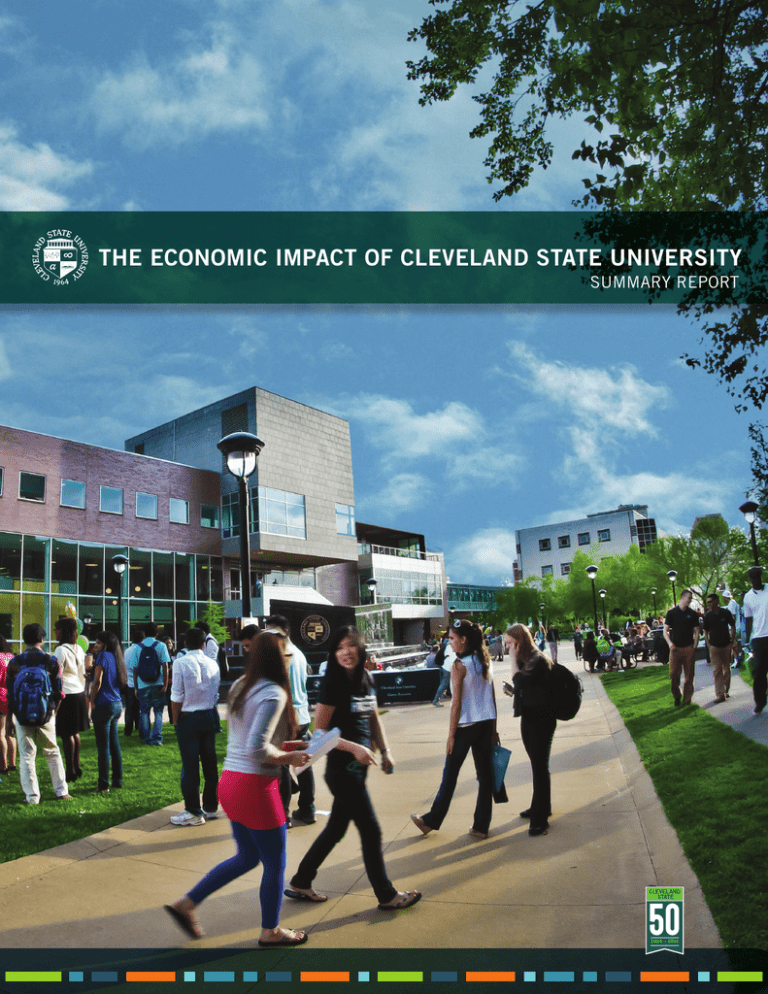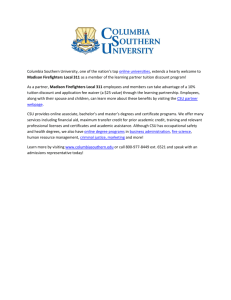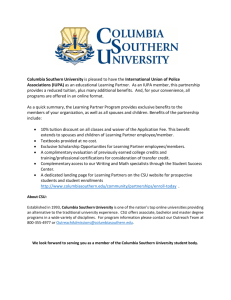THE ECONOMIC IMPACT OF CLEVELAND STATE UNIVERSITY SUMMARY REPORT 1964 – 2014
advertisement

THE ECONOMIC IMPACT OF CLEVELAND STATE UNIVERSITY SUMMARY REPORT 1964 – 2014 CLEVELAND STATE UNIVERSITY Dear Friends, Cleveland State University’s primary mission is to provide exceptional value to students seeking higher education, and in doing so the University has a profound effect on Northeast Ohio’s economy. CSU provides access to local high school graduates, aligns programs to workforce needs and increasingly attracts students from outside the region who add strength to our community. For this activity, the University provides an outstanding return on investment. Beyond being a major employer, CSU is a significant buyer of locally produced goods and services. In the past decade, CSU has invested more than $500 million to modernize and expand campus facilities, which has a multiplying effect on the surrounding community. CSU is now the largest landowner in downtown Cleveland, with 48 buildings that span 85 acres. The University has increased the number of students living on campus to more than 2,000, creating a vibrant urban neighborhood. Taken together, this progress has increased CSU’s role as a community anchor contributing to Cleveland’s renaissance. In sharing this Economic Impact Report with you, we encourage you to stay engaged with us as we create a best-in-class urban university, and a destination for learning, discovery and progress. Sincerely, Ronald M. Berkman President ECONOMIC IMPACT OF CSU OPERATIONS – FY 2013 Figures include University spending, student spending and visitor spending. EMPLOYMENT IMPACT LABOR INCOME IMPACT JOBS MILLION 6,739 $308 VALUE ADDED IMPACT $463 MILLION OUTPUT IMPACT $679 MILLION TAX IMPACT $67 MILLION STATE FUNDING TO CSU IN FY 2013-2014 = $65 MILLION Household income generated by CSU in Greater Cleveland = $308 million – A fivefold return on state tax dollars. Increase in GDP for Cleveland metropolitan area due to CSU operations = $463 million – A sevenfold return on state funding directed to regional gross domestic product (GDP). ECONOMIC IMPACT OF CSU OPERATIONS BY TYPE OF SPENDING, FY 2013 IMPACT TYPEEMPLOYMENTLABOR INCOMEVALUE ADDED UNIVERSITY OUTPUT TAXES 3,667$211,405,842 $267,004,309 $398,040,584 $21,108,071 STUDENT 2,977$93,905,324 $191,630,765 $273,922,711 $44,425,732 VISITOR 95$2,948,991 $4,624,670 $7,241,615 $1,083,879 TOTAL EFFECT 6,739$308,260,157 $463,259,744 $679,204,910 $66,617,682 The analysis illustrates five measures of CSU’s economic impact: EMPLOYMENT is a measure of jobs. LABOR INCOME is the summation of payroll paid to employees and contractors. VALUE ADDED measures the value of goods and services less the intermediary goods – often referred to as gross domestic product (GDP). OUTPUT measures the total value of goods and services produced as a result of CSU’s presence. TAXES include federal as well as state and local tax revenues. ECONOMIC IMPACT OF CSU OPERATIONS BY TYPE OF EFFECT, FY 2013 17% 68% INDUCED EFFECT 15% DIRECT EFFECT INDIRECT EFFECT 21% INDUCED EFFECT 63% 16% DIRECT EFFECT INDIRECT EFFECT PERCENT BY EMPLOYMENT PERCENT BY OUTPUT Each type of “impact” is a summation of direct, indirect and induced effects. DIRECT IMPACT includes the initial value of CSU jobs and payroll, as well as goods and services the University purchases in the study region. INDIRECT IMPACT m easures the jobs and production needed to manufacture goods and services required by the University. INDUCED IMPACT is the increase in spending of local households because of income received through their work at CSU and its suppliers. ECONOMIC IMPACT OF CAPITAL EXPENDITURES – FY 2009 TO FY 2013 Figures include investments in campus facilities, including new construction and renovations: EMPLOYMENT IMPACT LABOR INCOME IMPACT 1,945 $113 JOBS OUTPUT IMPACT VALUE ADDED IMPACT $286 $152 MILLION MILLION MILLION CSU CAPITAL SPENDING, FY 2009 TO 2013 $70,000,000 $60,000,000 $50,000,000 $61,500,000 $49,400,000 $40,000,000 $30,000,000 $22,800,000 $20,000,000 $10,000,000 $6,600,000 $9,300,000 $0 2009 2010 2011 2012 2013 TAX IMPACT $31 MILLION ABOUT CLEVELAND STATE UNIVERSITY ESTABLISHED: 1964 by action of the Ohio General Assembly ENROLLMENT: 17,730 GRADUATES: More than 120,000 — with an estimated 80 percent living in Northeast Ohio. ACADEMIC PROGRAMS: M ore than 200 2014 TUITION AND FEES, OHIO RESIDENT: Undergraduate $9,686; Graduate $12,804; Law $24,937 FULL-TIME EMPLOYEES: 511 faculty; 1,007 staff PART-TIME EMPLOYEES: 706 faculty and staff RESEARCH AWARDS: $12.05 million in 2013 ENDOWMENT: $72.3 million (as of June 30, 2014) ACADEMIC ORGANIZATION Monte Ahuja College of Business Maxine Goodman Levin College of Urban Affairs College of Education and Human Services College of Graduate Studies Washkewicz College of Engineering Cleveland-Marshall College of Law College of Liberal Arts and Social Sciences Jack, Joseph and Morton Mandel Honors College School of Nursing Partnership for Urban Health (M.D. program partnership with NEOMED) College of Sciences and Health Professions STUDENT PROFILE 55% 45% women men Approximately More than minorities, of which two-thirds are African American international students 27% 1,400 Average age 27 About 1/3 of students are in graduate school or law school The Economic Impact of Cleveland State University is based on a study completed by the Center for Economic Development at the Maxine Goodman Levin College of Urban Affairs in October 2014. The report assesses the economic impact of CSU on the five-county Cleveland metropolitan area, which includes Cuyahoga, Geauga, Lake, Lorain and Medina counties. Maxine Goodman Levin College of Urban Affairs PREPARED BY: CANDI CLOUSE, MSUS | ZIONA AUSTRIAN, PH.D. | SERENA ALEXANDER, MURP Cleveland State University is an Affirmative Action/Equal Opportunity institution. 141463



